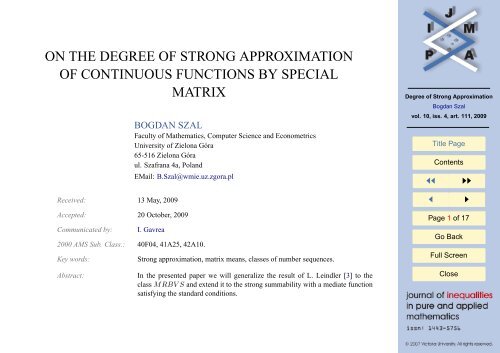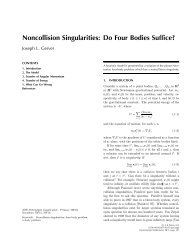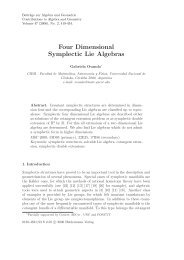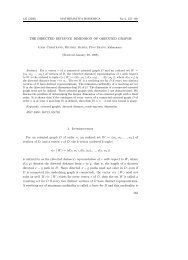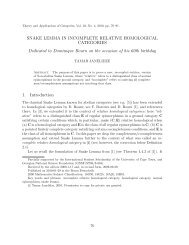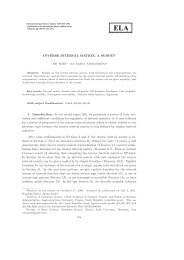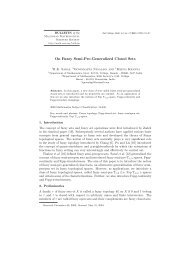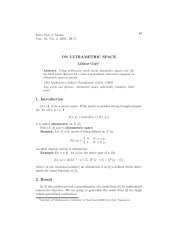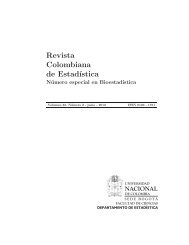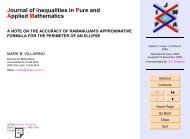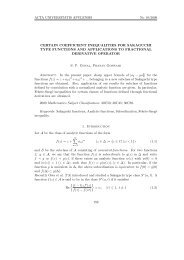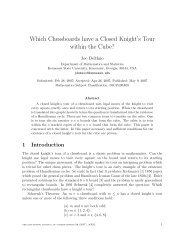On the Degree of Strong Approximation of Continuous Functions by ...
On the Degree of Strong Approximation of Continuous Functions by ...
On the Degree of Strong Approximation of Continuous Functions by ...
Create successful ePaper yourself
Turn your PDF publications into a flip-book with our unique Google optimized e-Paper software.
ON THE DEGREE OF STRONG APPROXIMATION<br />
OF CONTINUOUS FUNCTIONS BY SPECIAL<br />
MATRIX<br />
BOGDAN SZAL<br />
Faculty <strong>of</strong> Ma<strong>the</strong>matics, Computer Science and Econometrics<br />
University <strong>of</strong> Zielona Góra<br />
65-516 Zielona Góra<br />
ul. Szafrana 4a, Poland<br />
EMail: B.Szal@wmie.uz.zgora.pl<br />
<strong>Degree</strong> <strong>of</strong> <strong>Strong</strong> <strong>Approximation</strong><br />
Bogdan Szal<br />
vol. 10, iss. 4, art. 111, 2009<br />
Title Page<br />
Contents<br />
◭◭ ◮◮<br />
Received: 13 May, 2009<br />
◭<br />
◮<br />
Accepted: 20 October, 2009<br />
Communicated <strong>by</strong>: I. Gavrea<br />
2000 AMS Sub. Class.: 40F04, 41A25, 42A10.<br />
Key words:<br />
<strong>Strong</strong> approximation, matrix means, classes <strong>of</strong> number sequences.<br />
Page 1 <strong>of</strong> 17<br />
Go Back<br />
Full Screen<br />
Abstract:<br />
In <strong>the</strong> presented paper we will generalize <strong>the</strong> result <strong>of</strong> L. Leindler [3] to <strong>the</strong><br />
class MRBV S and extend it to <strong>the</strong> strong summability with a mediate function<br />
satisfying <strong>the</strong> standard conditions.<br />
Close
Contents<br />
1 Introduction 3<br />
2 Main Results 7<br />
3 Lemmas 9<br />
4 Pro<strong>of</strong> <strong>of</strong> Theorem 2.1 14<br />
<strong>Degree</strong> <strong>of</strong> <strong>Strong</strong> <strong>Approximation</strong><br />
Bogdan Szal<br />
vol. 10, iss. 4, art. 111, 2009<br />
Title Page<br />
Contents<br />
◭◭<br />
◭<br />
◮◮<br />
◮<br />
Page 2 <strong>of</strong> 17<br />
Go Back<br />
Full Screen<br />
Close
1. Introduction<br />
Let f be a continuous and 2π-periodic function and let<br />
(1.1) f (x) ∼ a ∞<br />
0<br />
2 + ∑<br />
(a n cos nx + b n sin nx)<br />
n=1<br />
be its Fourier series. Denote <strong>by</strong> S n (x) = S n (f, x) <strong>the</strong> n-th partial sum <strong>of</strong> (1.1) and<br />
<strong>by</strong> ω (f, δ) <strong>the</strong> modulus <strong>of</strong> continuity <strong>of</strong> f ∈ C 2π . The usual supremum norm will<br />
be denoted <strong>by</strong> ‖·‖ .<br />
Let A := (a nk ) (k, n = 0, 1, ...) be a lower triangular infinite matrix <strong>of</strong> real numbers<br />
satisfying <strong>the</strong> following conditions:<br />
(1.2) a nk ≥ 0 (0 ≤ k ≤ n) , a nk = 0, (k > n) and<br />
where k, n = 0, 1, 2, ....<br />
Let <strong>the</strong> A−transformation <strong>of</strong> (S n (f; x)) be given <strong>by</strong><br />
(1.3) t n (f) := t n (f; x) :=<br />
n∑<br />
a nk = 1,<br />
k=0<br />
n∑<br />
a nk S k (f; x) (n = 0, 1, ...)<br />
and <strong>the</strong> strong A r −transformation <strong>of</strong> (S n (f; x)) for r > 0 be given <strong>by</strong><br />
T n (f, r) := T n (f, r; x) :=<br />
k=0<br />
{ n∑<br />
k=0<br />
a nk |S k (f; x) − f (x)| r } 1<br />
r<br />
(n = 0, 1, ...) .<br />
<strong>Degree</strong> <strong>of</strong> <strong>Strong</strong> <strong>Approximation</strong><br />
Bogdan Szal<br />
vol. 10, iss. 4, art. 111, 2009<br />
Title Page<br />
Contents<br />
◭◭ ◮◮<br />
◭<br />
◮<br />
Page 3 <strong>of</strong> 17<br />
Go Back<br />
Full Screen<br />
Close<br />
Now we define two classes <strong>of</strong> sequences.
A sequence c := (c n ) <strong>of</strong> nonnegative numbers tending to zero is called <strong>the</strong> Rest<br />
Bounded Variation Sequence, or briefly c ∈ RBV S, if it has <strong>the</strong> property<br />
∞∑<br />
(1.4)<br />
|c n − c n+1 | ≤ K (c) c m<br />
n=m<br />
for m = 0, 1, 2, ..., where K (c) is a constant depending only on c (see [3]).<br />
A null sequence c := (c n ) <strong>of</strong> positive numbers is called <strong>of</strong> Mean Rest Bounded<br />
Variation, or briefly c ∈ MRBV S, if it has <strong>the</strong> property<br />
(1.5)<br />
∞∑<br />
n=2m<br />
|c n − c n+1 | ≤ K (c)<br />
1<br />
m + 1<br />
2m∑<br />
c n<br />
for m = 0, 1, 2, ... (see [5]).<br />
Therefore we assume that <strong>the</strong> sequence (K (α n )) ∞ n=0<br />
is bounded, that is, <strong>the</strong>re<br />
exists a constant K such that<br />
0 ≤ K (α n ) ≤ K<br />
holds for all n, where K (α n ) denotes <strong>the</strong> sequence <strong>of</strong> constants appearing in <strong>the</strong><br />
inequalities (1.4) or (1.5) for <strong>the</strong> sequence α n := (a nk ) ∞ k=0<br />
. Now we can give some<br />
conditions to be used later on. We assume that for all n<br />
∞∑<br />
(1.6)<br />
|a nk − a nk+1 | ≤ Ka nm (0 ≤ m ≤ n)<br />
and<br />
(1.7)<br />
∞∑<br />
k=2m<br />
k=m<br />
|a nk − a nk+1 | ≤ K 1<br />
m + 1<br />
2m∑<br />
k=m<br />
n=m<br />
a nk (0 ≤ 2m ≤ n)<br />
<strong>Degree</strong> <strong>of</strong> <strong>Strong</strong> <strong>Approximation</strong><br />
Bogdan Szal<br />
vol. 10, iss. 4, art. 111, 2009<br />
Title Page<br />
Contents<br />
◭◭ ◮◮<br />
◭<br />
◮<br />
Page 4 <strong>of</strong> 17<br />
Go Back<br />
Full Screen<br />
Close
hold if α n := (a nk ) ∞ k=0<br />
belongs to RBV S or MRBV S, respectively.<br />
In [1] and [2] P. Chandra obtained some results on <strong>the</strong> degree <strong>of</strong> approximation<br />
for <strong>the</strong> means (1.3) with a mediate function H such that:<br />
(1.8)<br />
and<br />
(1.9)<br />
∫ π<br />
u<br />
ω (f; t)<br />
t 2 dt = O (H (u)) (u → 0 + ) , H (t) ≥ 0<br />
∫ t<br />
0<br />
H (u) du = O (tH (t)) (t → O + ) .<br />
In [3], L. Leindler generalized this result to <strong>the</strong> class RBV S. Namely, he proved<br />
<strong>the</strong> following <strong>the</strong>orem:<br />
Theorem 1.1. Let (1.2), (1.6), (1.8) and (1.9) hold. Then for f ∈ C 2π<br />
It is clear that<br />
‖t n (f) − f‖ = O (a n0 H (a n0 )) .<br />
(1.10) RBV S ⊆ MRBV S.<br />
In [7], we proved that RBV S ≠ MRBV S. Namely, we showed that <strong>the</strong> sequence<br />
⎧<br />
⎨ 1 if n = 1,<br />
d n :=<br />
⎩<br />
if µ m ≤ n < µ m+1 ,<br />
1+m+(−1) n m<br />
(2 µm ) 2 m<br />
where µ m = 2 m for m = 1, 2, 3, ..., belongs to <strong>the</strong> class MRBV S but it does not<br />
belong to <strong>the</strong> class RBV S.<br />
<strong>Degree</strong> <strong>of</strong> <strong>Strong</strong> <strong>Approximation</strong><br />
Bogdan Szal<br />
vol. 10, iss. 4, art. 111, 2009<br />
Title Page<br />
Contents<br />
◭◭ ◮◮<br />
◭<br />
◮<br />
Page 5 <strong>of</strong> 17<br />
Go Back<br />
Full Screen<br />
Close
In <strong>the</strong> present paper we will generalize <strong>the</strong> mentioned result <strong>of</strong> L. Leindler [3] to<br />
<strong>the</strong> class MRBV S and extend it to strong summability with a mediate function H<br />
defined <strong>by</strong> <strong>the</strong> following conditions:<br />
(1.11)<br />
and<br />
(1.12)<br />
∫ π<br />
u<br />
ω r (f; t)<br />
t 2 dt = O (H (r; u)) (u → 0 + ) , H (t) ≥ 0 and r > 0,<br />
∫ t<br />
0<br />
H (r; u) du = O (tH (r; t)) (t → O + ) .<br />
By K 1 , K 2 , . . . we shall denote ei<strong>the</strong>r an absolute constant or a constant depending<br />
on <strong>the</strong> indicated parameters, not necessarily <strong>the</strong> same in each occurrence.<br />
<strong>Degree</strong> <strong>of</strong> <strong>Strong</strong> <strong>Approximation</strong><br />
Bogdan Szal<br />
vol. 10, iss. 4, art. 111, 2009<br />
Title Page<br />
Contents<br />
◭◭ ◮◮<br />
◭<br />
◮<br />
Page 6 <strong>of</strong> 17<br />
Go Back<br />
Full Screen<br />
Close
2. Main Results<br />
Our main results are <strong>the</strong> following.<br />
Theorem 2.1. Let (1.2), (1.7) and (1.11) hold. Then for f ∈ C 2π and r > 0<br />
( { (<br />
(2.1) ‖T n (f, r)‖ = O a n0 H r; π )} )<br />
1<br />
r<br />
.<br />
n<br />
If, in addition (1.12) holds, <strong>the</strong>n<br />
(2.2) ‖T n (f, r)‖ = O<br />
Using <strong>the</strong> inequality<br />
we can formulate <strong>the</strong> following corollary.<br />
(<br />
)<br />
{a n0 H (r; a n0 )} 1 r<br />
.<br />
‖t n (f) − f‖ ≤ ‖T n (f, 1)‖ ,<br />
Corollary 2.2. Let (1.2), (1.7) and (1.11) hold. Then for f ∈ C 2π<br />
( (<br />
‖t n (f) − f‖ = O a n0 H 1; π ))<br />
.<br />
n<br />
If, in addition (1.12) holds, <strong>the</strong>n<br />
‖t n (f) − f‖ = O (a n0 H (1; a n0 )) .<br />
<strong>Degree</strong> <strong>of</strong> <strong>Strong</strong> <strong>Approximation</strong><br />
Bogdan Szal<br />
vol. 10, iss. 4, art. 111, 2009<br />
Title Page<br />
Contents<br />
◭◭ ◮◮<br />
◭<br />
◮<br />
Page 7 <strong>of</strong> 17<br />
Go Back<br />
Full Screen<br />
Close<br />
Remark 1. By <strong>the</strong> embedding relation (1.7) we can observe that Theorem 1.1 follows<br />
from Corollary 2.2.
For special cases, putting<br />
⎧<br />
⎪⎨<br />
t rα−1 if αr < 1,<br />
H (r; t) = ln π if αr = 1,<br />
t<br />
⎪⎩<br />
K 1 if αr > 1,<br />
where r > 0 and 0 < α ≤ 1, we can derive from Theorem 2.1 <strong>the</strong> next corollary.<br />
Corollary 2.3. Under <strong>the</strong> conditions (1.2) and (1.7) we have, for f ∈ C 2π and r > 0,<br />
⎧<br />
O ({a n0 } α ) if αr < 1,<br />
⎪⎨ ({ ( ) } α )<br />
π<br />
‖T n (f, r)‖ = O ln<br />
a n0<br />
a n0 if αr = 1,<br />
( )<br />
⎪⎩ O {a n0 } 1 r<br />
if αr > 1.<br />
<strong>Degree</strong> <strong>of</strong> <strong>Strong</strong> <strong>Approximation</strong><br />
Bogdan Szal<br />
vol. 10, iss. 4, art. 111, 2009<br />
Title Page<br />
Contents<br />
◭◭ ◮◮<br />
◭<br />
◮<br />
Page 8 <strong>of</strong> 17<br />
Go Back<br />
Full Screen<br />
Close
3. Lemmas<br />
To prove our main result we need <strong>the</strong> following lemmas.<br />
Lemma 3.1 ([6]). If (1.11) and (1.12) hold, <strong>the</strong>n for r > 0<br />
∫ s<br />
0<br />
ω r (f; t)<br />
dt = O (sH (r; s)) (s → 0 + ) .<br />
t<br />
Lemma 3.2. If (1.2) and (1.7) hold, <strong>the</strong>n for f ∈ C 2π and r > 0<br />
⎛{ n∑<br />
} ⎞<br />
1<br />
r<br />
(3.1) ‖T n (f, r)‖ C<br />
≤ O ⎝ a nk Ek r (f) ⎠ ,<br />
k=0<br />
where E n (f) denotes <strong>the</strong> best approximation <strong>of</strong> <strong>the</strong> function f <strong>by</strong> trigonometric<br />
polynomials <strong>of</strong> order at most n.<br />
Pro<strong>of</strong>. It is clear that (3.1) holds for n = 0, 1, ..., 5. Namely, <strong>by</strong> <strong>the</strong> well known<br />
inequality [8]<br />
(3.2) ‖σ n,m − f‖ ≤ 2 n + 1<br />
m + 1 E n (f) (0 ≤ m ≤ n) ,<br />
where<br />
for m = 0, we obtain<br />
σ n,m (f; x) = 1<br />
m + 1<br />
n∑<br />
k=n−m<br />
S k (f; x) ,<br />
n∑<br />
{T n (f, r; x)} r ≤ 12 r a nk Ek r (f)<br />
k=0<br />
<strong>Degree</strong> <strong>of</strong> <strong>Strong</strong> <strong>Approximation</strong><br />
Bogdan Szal<br />
vol. 10, iss. 4, art. 111, 2009<br />
Title Page<br />
Contents<br />
◭◭ ◮◮<br />
◭<br />
◮<br />
Page 9 <strong>of</strong> 17<br />
Go Back<br />
Full Screen<br />
Close
and (3.1) is obviously valid, for n ≤ 5.<br />
Let n ≥ 6 and let m = m n be such that<br />
Hence<br />
2 m+1 + 4 ≤ n < 2 m+2 + 4.<br />
{T n (f, r; x)} r ≤<br />
+<br />
m−1<br />
∑<br />
3∑<br />
a nk |S k (f; x) − f (x)| r<br />
k=0<br />
2 k+1 ∑+4<br />
k=1 i=2 k +2<br />
a ni |S i (f; x) − f (x)| r +<br />
n∑<br />
k=2 m +5<br />
a nk |S k (f; x) − f (x)| r .<br />
Applying <strong>the</strong> Abel transformation and (3.2) to <strong>the</strong> first sum we obtain<br />
{T n (f, r; x)} r<br />
≤ 8 r<br />
3∑<br />
a nk Ek r (f) +<br />
k=0<br />
+a n,2 k+1 +4<br />
+<br />
∑n−1<br />
k=2 m +2<br />
+ a nn<br />
n∑<br />
m−1<br />
∑<br />
k=1<br />
2 k+1 ∑+4<br />
i=2 k +2<br />
⎛<br />
⎝<br />
∑<br />
2 k+1 +3<br />
i=2 k +2<br />
(a nk − a n,k+1 )<br />
k=2 m +2<br />
(a ni − a n,i+1 )<br />
⎞<br />
|S i (f; x) − f (x)| r ⎠<br />
k∑<br />
|S k (f; x) − f (x)| r<br />
i∑<br />
l=2 k +2<br />
l=2 m−1 |S l (f; x) − f (x)| r<br />
|S l (f; x) − f (x)| r<br />
<strong>Degree</strong> <strong>of</strong> <strong>Strong</strong> <strong>Approximation</strong><br />
Bogdan Szal<br />
vol. 10, iss. 4, art. 111, 2009<br />
Title Page<br />
Contents<br />
◭◭ ◮◮<br />
◭<br />
◮<br />
Page 10 <strong>of</strong> 17<br />
Go Back<br />
Full Screen<br />
Close
≤ 8 r<br />
3∑<br />
a nk Ek r (f) +<br />
k=0<br />
+a n,2 k+1 +4<br />
+<br />
∑n−1<br />
k=2 m +2<br />
2 m+2 ∑+4<br />
+ a nn<br />
m−1<br />
∑<br />
k=1<br />
2 k+1 ∑+4<br />
i=2 k +2<br />
⎛<br />
⎝<br />
∑<br />
2 k+1 +3<br />
i=2 k +2<br />
2 k+1 ∑+3<br />
|a ni − a n,i+1 | |S l (f; x) − f (x)| r<br />
⎞<br />
|S i (f; x) − f (x)| r ⎠<br />
l=2 k +2<br />
2 m+2 ∑+3<br />
|a nk − a n,k+1 | |S l (f; x) − f (x)| r<br />
k=2 m +2<br />
l=2 m +2<br />
|S k (f; x) − f (x)| r .<br />
Using <strong>the</strong> well-known Leindler’s inequality [4]<br />
{<br />
} 1<br />
s<br />
1<br />
n∑<br />
|S k (f; x) − f (x)| s<br />
m + 1<br />
k=n−m<br />
for 0 ≤ m ≤ n, m = O (n) and s > 0, we obtain<br />
3∑<br />
{T n (f, r; x)} r ≤ 8 r a nk Ek r (f)<br />
+ K 2<br />
⎧<br />
⎨<br />
⎩<br />
m−1<br />
∑<br />
k=1<br />
k=0<br />
⎛<br />
⎛<br />
⎝ ( 2 k + 3 ) E r 2 k +2 (f) ∑<br />
2 k+1 +3<br />
⎝<br />
i=2 k +2<br />
3 (2 m + 1) E r 2 m +2<br />
≤ K 1 E n−m (f)<br />
⎞⎞<br />
|a ni − a n,i+1 | + a n,2<br />
⎠⎠<br />
k+1 +4<br />
( n−1 ∑<br />
k=2 m +2<br />
|a nk − a n,k+1 | + a nn<br />
)}<br />
.<br />
<strong>Degree</strong> <strong>of</strong> <strong>Strong</strong> <strong>Approximation</strong><br />
Bogdan Szal<br />
vol. 10, iss. 4, art. 111, 2009<br />
Title Page<br />
Contents<br />
◭◭ ◮◮<br />
◭<br />
◮<br />
Page 11 <strong>of</strong> 17<br />
Go Back<br />
Full Screen<br />
Close
Using (1.7) we get<br />
3∑<br />
{T n (f, r; x)} r ≤ 8 r a nk Ek r (f)<br />
+ K 2<br />
⎧<br />
⎨<br />
⎩<br />
m−1<br />
∑<br />
k=1<br />
k=0<br />
⎛<br />
⎛<br />
⎝ ( 2 k + 3 ) E r 2 k +2 (f) 1<br />
⎝K<br />
2 k−1 + 2<br />
(<br />
3 (2 m + 1) E2 r 1<br />
m +2 (f) K<br />
2 m−1 + 2<br />
In view <strong>of</strong> (1.7), we also obtain for 1 ≤ k ≤ m − 1,<br />
and<br />
a n,2 k+1 +4 =<br />
a nn =<br />
≤<br />
≤<br />
∞∑<br />
i=2 k+1 +4<br />
∞∑<br />
i=2 k +2<br />
(a ni − a ni+1 ) ≤<br />
2∑<br />
k +2<br />
i=2 k−1 +1<br />
∞∑<br />
i=2 k+1 +4<br />
1<br />
|a ni − a ni+1 | ≤ K<br />
2 k−1 + 2<br />
∞∑<br />
(a ni − a ni+1 ) ≤<br />
i=n<br />
∞∑<br />
i=2 m +2<br />
∞∑<br />
|a ni − a ni+1 |<br />
i=n<br />
1<br />
|a ni − a ni+1 | ≤ K<br />
2 m−1 + 2<br />
⎞⎞<br />
a ni + a n,2<br />
⎠⎠<br />
k+1 +4<br />
2∑<br />
m +2<br />
i=2 m−1 +1<br />
|a ni − a ni+1 |<br />
2∑<br />
k +2<br />
i=2 k−1 +1<br />
2∑<br />
m +2<br />
i=2 m−1 +1<br />
a ni + a nn<br />
)}<br />
a ni<br />
a ni.<br />
.<br />
<strong>Degree</strong> <strong>of</strong> <strong>Strong</strong> <strong>Approximation</strong><br />
Bogdan Szal<br />
vol. 10, iss. 4, art. 111, 2009<br />
Title Page<br />
Contents<br />
◭◭ ◮◮<br />
◭<br />
◮<br />
Page 12 <strong>of</strong> 17<br />
Go Back<br />
Full Screen<br />
Close
Hence<br />
3∑<br />
{T n (f, r; x)} r ≤ 8 r a nk Ek r (f)<br />
≤ 8 r<br />
≤ K 4<br />
This ends our pro<strong>of</strong>.<br />
k=0<br />
+ K 3<br />
⎧<br />
⎨<br />
⎩<br />
3∑<br />
k=0<br />
m−1<br />
∑<br />
k=1<br />
2 k +2<br />
E r 2 k +2 (f) ∑<br />
i=2 k−1 +1<br />
2∑<br />
m +2<br />
a nk Ek r (f) + 2K 3<br />
n∑<br />
a nk Ek r (f) .<br />
k=0<br />
k=3<br />
a ni + E r 2 m +2 (f)<br />
a nk E r k (f)<br />
2∑<br />
m +2<br />
i=2 m−1 +1<br />
a ni<br />
⎫<br />
⎬<br />
⎭<br />
<strong>Degree</strong> <strong>of</strong> <strong>Strong</strong> <strong>Approximation</strong><br />
Bogdan Szal<br />
vol. 10, iss. 4, art. 111, 2009<br />
Title Page<br />
Contents<br />
◭◭ ◮◮<br />
◭<br />
◮<br />
Page 13 <strong>of</strong> 17<br />
Go Back<br />
Full Screen<br />
Close
4. Pro<strong>of</strong> <strong>of</strong> Theorem 2.1<br />
Using Lemma 3.2 we have<br />
(4.1)<br />
|T n (f, r; x)| ≤ K 1<br />
{ n∑<br />
k=0<br />
a nk E r k (f)<br />
} 1<br />
r<br />
≤ K 2<br />
{ n∑<br />
k=0<br />
a nk ω r (f;<br />
) } 1 r<br />
π<br />
.<br />
k + 1<br />
If (1.7) holds, <strong>the</strong>n, for any m = 1, 2, ..., n,<br />
m−1<br />
∑<br />
a nm − a n0 ≤ |a nm − a n0 | = |a n0 − a nm | =<br />
(a nk − a nk+1 )<br />
∣<br />
∣<br />
whence<br />
≤<br />
m−1<br />
∑<br />
k=0<br />
|a nk − a nk+1 | ≤<br />
k=0<br />
∞∑<br />
|a nk − a nk+1 | ≤ Ka n0 ,<br />
k=0<br />
(4.2) a nm ≤ (K + 1) a n0 .<br />
Therefore, <strong>by</strong> (1.2),<br />
(4.3) (K + 1) (n + 1) a n0 ≥<br />
n∑<br />
a nk = 1.<br />
k=0<br />
First we prove (2.1). Using (4.2), we get<br />
n∑<br />
)<br />
a nk ω<br />
(f;<br />
r π<br />
≤ (K + 1) a n0<br />
k + 1<br />
k=0<br />
n∑<br />
)<br />
ω<br />
(f;<br />
r π<br />
k + 1<br />
k=0<br />
<strong>Degree</strong> <strong>of</strong> <strong>Strong</strong> <strong>Approximation</strong><br />
Bogdan Szal<br />
vol. 10, iss. 4, art. 111, 2009<br />
Title Page<br />
Contents<br />
◭◭ ◮◮<br />
◭<br />
◮<br />
Page 14 <strong>of</strong> 17<br />
Go Back<br />
Full Screen<br />
Close
≤ K 3 a n0<br />
∫ n+1<br />
1<br />
= πK 3 a n0<br />
∫ π<br />
π<br />
n+1<br />
and <strong>by</strong> (4.1), (1.11) we obtain that (2.1) holds.<br />
Now, we prove (2.2). From (4.3) we obtain<br />
n∑<br />
)<br />
a nk ω<br />
(f;<br />
r π<br />
k + 1<br />
k=0<br />
≤<br />
[<br />
1<br />
]−1<br />
(K+1)a n0<br />
∑<br />
k=0<br />
a nk ω r (f;<br />
)<br />
π<br />
+<br />
k + 1<br />
[<br />
k=<br />
(<br />
ω r f; π )<br />
dt<br />
t<br />
ω r (f; u)<br />
du<br />
u 2<br />
n∑<br />
1<br />
(K+1)a n0<br />
]−1<br />
a nk ω r (f;<br />
)<br />
π<br />
.<br />
k + 1<br />
Again using (1.2), (4.2) and <strong>the</strong> monotonicity <strong>of</strong> <strong>the</strong> modulus <strong>of</strong> continuity, we get<br />
n∑<br />
)<br />
a nk ω<br />
(f;<br />
r π<br />
k + 1<br />
k=0<br />
[<br />
1<br />
]−1<br />
(K+1)a<br />
∑ n0<br />
)<br />
≤ (K + 1) a n0 ω<br />
(f;<br />
r π<br />
k + 1<br />
k=0<br />
n∑<br />
+ K 4 ω r (f; π (K + 1) a no )<br />
[<br />
k=<br />
1<br />
(K+1)a n0<br />
]−1<br />
a nk<br />
<strong>Degree</strong> <strong>of</strong> <strong>Strong</strong> <strong>Approximation</strong><br />
Bogdan Szal<br />
vol. 10, iss. 4, art. 111, 2009<br />
Title Page<br />
Contents<br />
◭◭ ◮◮<br />
◭<br />
◮<br />
Page 15 <strong>of</strong> 17<br />
Go Back<br />
Full Screen<br />
Close
(4.4)<br />
Moreover<br />
(4.5)<br />
≤ K 5 a n0<br />
∫ 1<br />
(K+1)a n0<br />
1<br />
( ∫ π<br />
≤ K 6 a n0<br />
(<br />
ω r f; π )<br />
t<br />
a n0<br />
ω r (f; u)<br />
u 2 du + ω r (f; a n0 )<br />
(<br />
ω r (f; a n0 ) ≤ 4 r ω r f; a )<br />
n0<br />
∫ 2<br />
an0<br />
≤ 2 · 4 r<br />
dt + K 4 ω r (f; π (K + 1) a no )<br />
)<br />
.<br />
a n0<br />
2<br />
≤ 2 · 4 r ∫ an0<br />
0<br />
ω r (f; t)<br />
dt<br />
t<br />
ω r (f; t)<br />
dt.<br />
t<br />
Thus collecting our partial results (4.1), (4.4), (4.5) and using (1.11) and Lemma 3.1<br />
we can see that (2.2) holds. This completes our pro<strong>of</strong>.<br />
□<br />
<strong>Degree</strong> <strong>of</strong> <strong>Strong</strong> <strong>Approximation</strong><br />
Bogdan Szal<br />
vol. 10, iss. 4, art. 111, 2009<br />
Title Page<br />
Contents<br />
◭◭ ◮◮<br />
◭<br />
◮<br />
Page 16 <strong>of</strong> 17<br />
Go Back<br />
Full Screen<br />
Close
References<br />
[1] P. CHANDRA, <strong>On</strong> <strong>the</strong> degree <strong>of</strong> approximation <strong>of</strong> a class <strong>of</strong> functions <strong>by</strong> means<br />
<strong>of</strong> Fourier series, Acta Math. Hungar., 52 (1988), 199–205.<br />
[2] P. CHANDRA, A note on <strong>the</strong> degree <strong>of</strong> approximation <strong>of</strong> continuous function,<br />
Acta Math. Hungar., 62 (1993), 21–23.<br />
[3] L. LEINDLER, <strong>On</strong> <strong>the</strong> degree <strong>of</strong> approximation <strong>of</strong> continuous functions, Acta<br />
Math. Hungar., 104 (1-2), (2004), 105–113.<br />
[4] L. LEINDLER, <strong>Strong</strong> <strong>Approximation</strong> <strong>by</strong> Fourier Series, Akadèmiai Kiadò, Budapest<br />
(1985).<br />
[5] L. LEINDLER, Integrability conditions pertaining to Orlicz space, J. Inequal.<br />
Pure and Appl. Math., 8(2) (2007), Art. 38.<br />
[6] B. SZAL, <strong>On</strong> <strong>the</strong> rate <strong>of</strong> strong summability <strong>by</strong> matrix means in <strong>the</strong> generalized<br />
Hölder metric, J. Inequal. Pure and Appl. Math., 9(1) (2008), Art. 28.<br />
[7] B. SZAL, A note on <strong>the</strong> uniform convergence and boundedness a generalized<br />
class <strong>of</strong> sine series, Comment. Math., 48(1) (2008), 85–94.<br />
[8] Ch. J. DE LA VALLÉE - POUSSIN, Leçons sur L’<strong>Approximation</strong> des Fonctions<br />
d’une Variable Réelle, Paris (1919).<br />
<strong>Degree</strong> <strong>of</strong> <strong>Strong</strong> <strong>Approximation</strong><br />
Bogdan Szal<br />
vol. 10, iss. 4, art. 111, 2009<br />
Title Page<br />
Contents<br />
◭◭ ◮◮<br />
◭<br />
◮<br />
Page 17 <strong>of</strong> 17<br />
Go Back<br />
Full Screen<br />
Close


